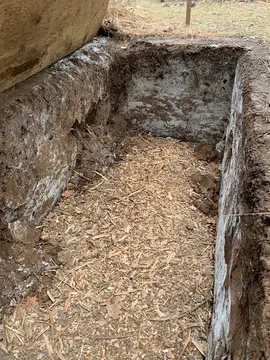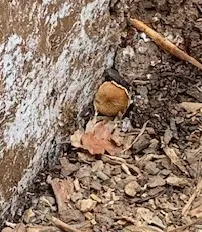The Web of Life

When something dies in the forest, fungi break it down and allow the essential elements such as magnesium and potassium to be re-used to create more life. The forest’s mycological network then transports those critical resources from where they rest to where they’re needed.
While the beautiful trees of the forest get star billing, it’s actually the underground fungal web that enables the forest to thrive. Without an active fungal network, the minerals crucial to plant growth won’t be able to reenter the biosphere in the near future. One of the reasons that a catastrophic forest fire can be so damaging is that the intense heat can sterilize the soil, kill off the fungi, and thereby inhibit the growth of new trees.
When someone selects their spot in the Herland Forest, we dig the grave by hand (to minimize compacting the soil) and fill it with wood chips from our forest. When a person is looking at passing in the near future (what’s referred to as “imminent need”), we lay down a bed of a hundred gallons of chips and cover the grave with a sheet of plywood to await the day when the grave is needed.
The plywood keeps the interior of the grave dark and moist—just what the fungi need in order to propagate. This allows the fungi to get a head start on converting the wood chips into soil. Without a source of nitrogen, fungal growth will be limited, but the fungi still does the best it can to establish itself throughout the grave.

Here’s an example of shitake mushrooms growing in the bed of oak wood chips in a prepared grave. This stage of the process is similar to a car’s engine idling on a cold, winter day warming up while it awaits the arrival of the passenger.
Soon, the sides of the grave are covered with mycelium. In the pic above, you can see the eager fungi lining the sides of the grave. They’re like runners at the starting line of a marathon milling around waiting for the race to begin. Then when the decedent’s nitrogen-rich remains are added to the grave, the conversion of biomass to soil kicks into over-drive.
In commercial burials, many things are done to interfere with nature’s desire to reclaim the body: embalming, casket burial, containment in a concrete vault, etc. Ultimately, nature WILL prevail, but those commercial additions slow down nature’s ability to reclaim the body’s essential elements (magnesium, potassium, phosphorus, etc.). Nature can’t reuse those nutrients until the fungi have gotten to the remains and returned those nutrients to the living forest. Only then can the forest use the body’s nutrient to grown more trees.
By definition, “green burial” is about what you don’t do: no embalming, no casket, no concrete vault, etc. That’s why we refer to what happens in the Herland Forest as Enhanced Natural Burial since our process is designed to accelerate the ongoing creation of new life.
There’s a similar approach used in our Natural Organic Reduction work. Because we do this work outside in nature, instead of inside a heated warehouse in an industrial park, we’re free to allow the Natural Organic Reduction process to proceed at nature’s pace. It happens faster in the summer, and slower in the winter, but no matter—we give the process whatever amount of time it needs. We’re a non-profit helping the forest thrive, not a for-profit with the goal of maximizing profit.
The last step in Herland’s natural organic reduction process is a thermal treatment to ensure that potentially harmful bacteria such as e.coli and salmonella are killed. But what’s bad for those bacteria is actually good for the fungi.

Here’s a pic showing the fungal bloom that happens as the sterilizing heat helps the fungi break down cellulose into xylose (aka “wood sugar”). Xylose is the sugar that fuels the forest’s underground network. In the forest, xylose plays the same role as the diesel fuel that powers the long-haul trucks that bring the food you need to you–it’s the fuel that enables the fungi to bring those essential nutrients like magnesium to the trees.

Herland’s job is to carry out the decedent’s wishes by facilitating this process. If someone wants to rest in the forest, then Enhanced Natural Burial is the option we recommend. If they want to return to their own home and nourish their own garden, then Natural Organic Reduction is the recommended option.
Ultimately, those are just two different paths leading us home.
